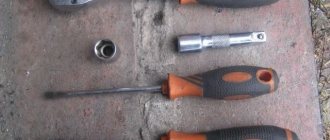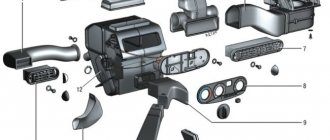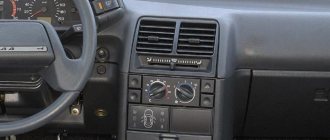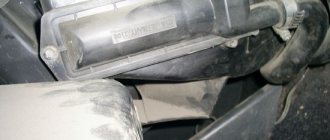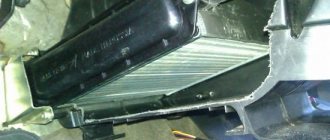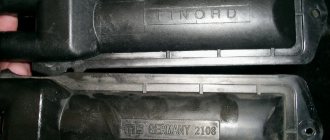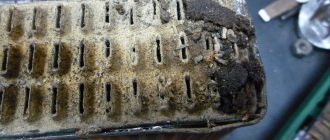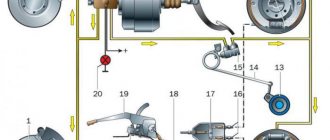New cooling system
The sequence of your actions in this case is as follows:
- First of all, for safety reasons, disconnect the negative terminal of the battery. We drain the cooled antifreeze or antifreeze, first opening the expander cap. To drain the liquid you will need a container with a volume of 4-5 liters.
- Now, after unscrewing the two nuts, remove the wipers from the car.
- Then we dismantle the released protective plastic cover under the windshield, which is secured with 2 nuts and 4 self-tapping screws.
- To access the stove, remove the frill of the car by unscrewing 5 self-tapping screws, 1 screw and 2 nuts located at the bottom, in the middle of the frill, in the area of the steering rack.
- In order to remove the stove, remove the yellow cross brace, if any, as well as the curved bellows of the air filter.
- We pull the chokes off the radiator pipes.
- Then disconnect all electrical wires from the stove terminals.
- At the steering rack, unscrew 2 nuts that secure the heater, 1 nut securing the heater to the body.
- We unscrew the 3 screws connecting the two halves of the stove.
- We take it out by swinging the right side of the stove, first moving it to the right.
- The radiator in the removed half of the stove is secured with 3 screws. We take it out and replace it with a new one, not forgetting to put on the foam seal. We check the operation of the fan and, if necessary, repair it or replace it with a new one.
- Before installing the assembly, it is advisable to rinse the coolant supply hoses with running water.
- Assembly is carried out in reverse order.
Aluminum VS Copper: which radiator to choose?
Many years of experience in operating radiators made of various materials on domestic cars (including the VAZ-2112), it was noticed that its performance is not affected by the material from which it is made. Both copper and aluminum devices heat equally well.
The only criterion when choosing a radiator is its originality, since only a serious manufacturer is capable of producing a quality product. Therefore, when purchasing a heater radiator, it is necessary to pay attention to this criterion.
So, where exactly is the radiator of the VAZ-2112 stove? In the design of the interior heating system, the radiator is located inside the heater housing, occupying a horizontal position in relation to the central panel.
Let's sum it up
Replacing a vehicle heater radiator is not particularly difficult, however, it requires the utmost care from the performer and step-by-step execution of the work. Self-repair of the heating system of the VAZ-2110 will help you save money on the services of specialists and understand in more detail the functioning system of the car’s heater. Buy only high-quality certified parts so that in winter your car will delight you with comfort and coziness.
Removing the heater radiator
Your first priority is to get rid of the antifreeze. It is better to drain the coolant into a clean container if you filled it recently and it is in good condition. This will allow you to refill it later.
- Relieve pressure by opening the expansion tank cap. Just let the car cool down before doing this.
- Next, behind the ignition module, find the plug that needs to be unscrewed.
- You should have about 4 liters of coolant coming out of the hole. Therefore, prepare a container of appropriate size.
- Or you can drain through the expansion tank. Although this option is not particularly convenient.
After draining the coolant, you can begin further dismantling the radiator. But here the procedure depends on what kind of unit we are dealing with - a new or old model.
Let's consider both options separately.
Old stove
The radiator is removed from the engine compartment. This is done as follows:
- Remove the rubber frill seal;
- Under the brake master cylinder, locate the fasteners that hold the frill in place. Unscrew it;
- Now remove the screws that hold the right side of the frill in place. There should be four of them in total;
- Disconnect the two small clamps on the frill. They hold wires and hoses;
- The positive terminal and negative wire are disconnected from the fan;
- Move the left side of the frill forward a little, but you don’t need to remove it completely. All you need to do is unscrew a couple of fasteners;
- Remove the wind cover;
- If there is a coolant level sensor terminal, disconnect it;
- Remove the steam exhaust hose from the expansion tank.
Removing thermal insulation
Next, you need to remove some elements one by one. Proceed strictly in the specified sequence.
- Windshield washer hose.
- Wipers.
- Windshield trim. Heater housing clamps.
- Front part of the heater with fan.
- Cabin filter.
- The second part of the case is the fan.
- All hoses (steam outlet, return and supply).
- Radiator housing.
If your existing radiator is made of copper, the presence of a leak does not indicate a mandatory replacement. It can be soldered. Only this question is better to entrust to a specialist. Even if you pay more money, the decision will be competent and correct
So we figured out how to remove the heater radiator on an old-style VAZ 2110. When installing a new unit or a repaired old one, make sure that the pedal of the plastic housing from the fan fits into the groove. If this is not done, the gearbox will not be able to change the position of the damper. Consequently, there will be no heat inside the cabin.
In addition, it is better to replace this plastic pedal with an aluminum one. Not expensive, easy, but reliable and durable.
New stove
If you are dealing with a new type of stove, there are some nuances regarding fixing the heater to the body.
To remove the unit, you will need to dismantle several elements. Namely:
- There are screws at the bottom of the windshield, the middle one can be unscrewed;
- Also unscrewed is a pair of nuts that you will find slightly above the intake manifold;
- The nut located to the left of the filter must be removed;
- If there is a reservoir with washer fluid for the rear window, then it and the air filter are removed.
We recommend: Why do car brakes squeak and what can you do about it?
The new generation heater is distinguished by the fact that the design is detachable. This is quite easy to do to be able to replace the heater radiator.
Dismantling
First of all, you need to drain the antifreeze. If it turns out to be clean, it can then be refilled into a new radiator, so prepare a clean container.
We unscrew the cap on the expansion tank to let the pressure drop. Then we find the plug behind the ignition module and unscrew it completely. Pour 4 liters of antifreeze into the drain hole.
Another option is to drain through the expansion tank. Although this method is less convenient. You need to remove the hose by disconnecting it from the stove, and then the rubber pipe.
After draining the antifreeze, repairs are slightly different depending on the heater model.
How to remove the stove
Removing the stove on new VAZ-2110 models
First of all, drain the old antifreeze. To do this, the pressure in the system is released by opening the expansion cap. Next, we find the ignition control unit: the drain plug is hidden behind it; Unscrew it and wait for the liquid to be completely removed from the device.
The radiator is held on by 4 fasteners - a screw under the front glass, two bolts on the side of the intake manifold. There is also a nut next to the cabin air filter - it also needs to be removed. The driver has the opportunity to remove the radiator almost freely. But it will be so easy only for owners of restyled tens (VAZ-21103).
We also recommend reading our expert’s article, which talks about the features of tuning the VAZ-2110.
Removing the stove on old VAZ-2110 models
With the “old ladies” 1996-2001. everything is more complicated. The driver will have to remove the wipers, as well as the washer fluid supply line. Also superfluous will be a decorative trim under the forehead, a heater housing, a cabin air filter, a fan, and flexible heat supply hoses. AvtoVAZ engineers clearly did not want anyone to repair the stove themselves. Only by removing all the described parts will the car owner gain access to the interior heater radiator.
Fast way
The angry “vazovods” turned out to be no slouch and figured out how to remove the stove on a pre-restyling VAZ-2110. You will also have to work hard, but still less than with the standard algorithm.
Let us explain how to remove the stove on a VAZ-2110 in the simplest way:
- After draining the antifreeze and disconnecting all the pipes, we dismantle the expansion tank.
- The frill overlay will also get in the way, so we remove it.
- And now the highlight of the program: remove the brake pedal along with the vacuum booster.
- The repairman has a wonderful view of the radiator, and now nothing will prevent him from removing it after removing the fasteners.
Use this “life hack” if you don’t want to spend several hours with repairs.
Device
First of all, you should know the very structure of the heating system in order to clearly understand what and how to repair, because for the VAZ 2110, interruptions in the operation of the heater are a typical phenomenon, and from time to time requiring the intervention of reliable hands - be it a driver or a service station worker.
So, the heating system consists of: 1. The actual heater unit, which provides heating for the interior
It is represented (by importance of details):
- An electric motor on which a fan is also attached to pump hot air;
- A radiator, without which the entire system does not work. Moreover, unlike the old heater, the radiator of the VAZ 2110 stove of the new model does not have a tap that shuts off the flow of antifreeze (antifreeze) through the radiator. Thus, it is always (whether in winter or in summer) heated. This was done supposedly in order to eliminate leaks that were often observed through this tap, and also to heat the interior as quickly as possible when necessary. In the summer, the supply ventilation goes past the radiator, but still some VAZ 2110 owners, when repairing the stove, add this tap to the system;
- There are three dampers. One is responsible for air intake recirculation, the second opens/closes the heater duct, the third, the most important for the interior, controls the heater;
- A resistor that regulates the blowing speed.
Heater parts VAZ 2110
All parts are packaged in a block with additional valves, shields, and fittings. This entire device is housed in a housing and is located under the hood closer to the instrument panel.
2. The next block represents the air ducts of the VAZ 2110. They extend directly from the stove and provide:
- Interior ventilation through central nozzles;
- The air distributor works to supply heat (or regular air for ventilation);
- Two air ducts are directed to the rear of the cabin;
- There is a whole system of five nozzles for heating the feet;
- Two side air ducts provide heating for the side windows and part of the interior, providing better heating;
- Two nozzles for ventilation.
Operating principle of the heater
This, in a nutshell, is the principle of distribution of hot or cold air inside the VAZ 2110.
3. The electronic control unit for the stove operates from the passenger compartment. It includes:
- Controller handle. This device allows you to set the temperature in the cabin that the stove unit should produce. It turns on by turning the knob and sets the temperature from the air, the temperature of which will correspond to that outside, up to 30°C. Most often, this part is called the ACS controller (automatic heater control system);
- The temperature sensor is responsible for turning on the heater when the temperature in the cabin drops by 2 degrees against the set one. The sensor has a microfan, and if the control knob is in position A, then the micromotor in the stove block turns on and the damper begins to operate, ensuring proper heating. Therefore, before starting repairs of the heating system, the operation of this sensor is usually checked. It is located next to the heating lamp on the ceiling of the VAZ 2110. Since it is not repairable, in the event of a breakdown this device should be replaced immediately.
Ceiling interior air temperature sensor
When to change/remove the heater radiator
If you have a couple of days free, then you can shoot quite often if it brings moral satisfaction. If we change or remove the radiator, then there must be objective reasons for this. Since we need the stove to heat, we will remove it when it is not heating. But first you need to make sure that the problem is in the radiator. Even the very fact of an antifreeze leak can be caused not by the radiator at all, but by pipes of disgusting quality, which become woody and crack after a couple of years of operation. The difficulty is that the stove reliably hides its structure and is perfectly protected from industrial espionage, so that not a single part of it is accessible to enemies without disassembly.
Therefore, if antifreeze quickly leaks into the cabin or under the hood near the stove, you should at least try to determine the cause of the leak. A leak is fine, but with a groundless failure of the heater it’s more difficult. There can be many reasons:
- air lock in the heating circuit;
- clogged heater radiator;
- clogged cabin filter, if there is one at all;
- clogged air ducts;
- problems with the electric motor of the stove - it does not rotate, does not create pressure, creates insufficient pressure;
- electrical malfunctions - electronic climate control unit, violation of air recirculation operating modes, typical malfunctions of switches and regulators.
If there is still a need to replace the radiator, we will replace it, but first you need to select it.
Stories from our readers
“Fucking basin. "
Hi all! My name is Mikhail, now I’ll tell you a story about how I managed to exchange my two-wheeler for a 2010 Camry. It all started with the fact that I began to be wildly irritated by the breakdowns of the two-wheeler, it seemed like nothing serious was broken, but damn it, there were so many little things that really started to irritate me. This is where the idea arose that it was time to change the car to a foreign car. The choice fell on the melting Camry of the tenth years.
Yes, I had matured morally, but financially I just couldn’t handle it. I’ll say right away that I am against loans and taking a car, especially not a new one, on credit is unreasonable. My salary is 24k a month, so collecting 600-700 thousand is almost impossible for me. I started looking for different ways to make money on the Internet. You can’t imagine how many scams there are, what I haven’t tried: sports betting, network marketing, and even the volcano casino, where I successfully lost about 10 thousand ((The only direction in which it seemed to me that I could make money was currency trading on the stock exchange, they call it Forex. But when I started delving into it, I realized that it was very difficult for me. I continued to dig further and came across binary options. The essence is the same as in Forex, but it’s much easier to understand. I started reading forums, studying trading strategies. I tried it on a demo account, then opened a real account. To be honest, I didn’t manage to start earning money right away, until I understood all the mechanics of options, I lost about 3,000 rubles, but as it turned out, it was a precious experience. Now I earn 5-7 thousand rubles a day. I managed to get the car buy after half a year, but in my opinion this is a good result, and it’s not about the car, my life has changed, I naturally quit my job, I have more free time for myself and my family. You’ll laugh, but I work directly on the phone)) If If you want to change your life like me, then here’s what I advise you to do right now: 1. Register on the site 2. Practice on a Demo account (it’s free). 3. As soon as you get something on the Demo account, top up your REAL ACCOUNT and go to REAL MONEY! I also advise you to download the application to your phone, it’s much more convenient to work from your phone. Download here.
- Old style heater (until September 2003)
- New model heater (after September 2003)
The procedure for replacing the heater radiator of the old and new models will not differ significantly, but I will still tell you separately.
So, we buy everything necessary to replace the radiator (you will need at least 4 clamps) and take a short Phillips screwdriver with tweezers (they will help when installing hard-to-reach latches). It is important to choose a good heater radiator!
Drain the antifreeze:
- You can drain some of the antifreeze from the engine block. Unscrew the cap of the expansion tank (so that the pressure drops) and unscrew the drain plug, which is located behind the ignition module (unscrew it and put it aside). About 4 liters of antifreeze should come out of the previously placed bucket (if it’s clean, you can refill it later).
- And you can only drain it through the expansion tank. We remove the hose from the stove and pour out about 1 liter of antifreeze. Next, remove this rubber pipe (so as not to interfere) by loosening the three clamps:
Replacing the heater radiator on a Priora without and with air conditioning. This is AvtoVAZ
- The heat exchange device is represented by a radiator, through which the external air entering the cabin is heated;
- A fan driven by an electric motor promotes air circulation in the cabin;
- Damper that regulates the flow of incoming cold air;
- Dampers that regulate and distribute the flow of incoming warm air into the cabin.
- Disconnect the vehicle from the battery;
- Now you can start removing the windshield trim;
- The windshield wiper arms will interfere with operation, so they need to be removed;
- You also need to remove the plastic fluid supply tubes to the injectors;
- To remove the decorative trim of the windshield, you need to unscrew the seven screws that secure it;
- After this, you can remove the hood seal;
- There is a screw installed in the middle of the lining that tightens both halves of the lining;
- Next, use a screwdriver to pry off the plugs that cover the screws, unscrew them and remove the trim from the body;
- After this, you should begin to remove the sound insulation of the engine compartment; to do this, you should unscrew the screws that secure it, and then remove the left and right linings;
- Now let's move on to the pipes going to the heater radiator. You should loosen the clamps and remove the pipes. Place a container under them, as antifreeze may spill. The removed pipes should be plugged in an accessible way;
- Next, you should disconnect all connectors with wires that go to the heater;
- After this you will need wrenches. Using a socket wrench set to “10” you should unscrew three nuts, and one nut will be used for a wrench “8”;
- The wiring harness interferes with removing the heater. You need to remove the holder and take it to the side along with the wires;
- Now the work will continue inside the car. You will need a “13” socket wrench to remove the bracket with the brake pedal, which then needs to be moved to the side;
- The heater is accessible and can be removed for repair and maintenance;
- To remove the radiator, you need to use a Phillips screwdriver to use three screws, after which it can be easily removed. In many cases, it is dirty, so it should be cleaned with a brush and blown with compressed air.
- Installation is carried out in reverse order.
- Remove the rubber seal from the windshield lining;
- After this, they begin soundproofing the engine compartment. Some screws are not easy to get to, be patient, be careful and everything will work out;
- Now you can begin to remove the foam gasket on the pipes;
- After this, you can remove the plastic radiator cap; to do this, you need to unscrew three screws;
- Once access to the pipes is available, you can begin to remove them. You should not completely drain the antifreeze from the system; you can substitute a small container and drain it from the heater radiator and expansion tank, and then plug the pipes.
Setting the temperature of the supplied air from the heater
To fine-tune the control unit, it has an adjusting screw. To check the accuracy of temperature control, close all doors and windows and place a control thermometer next to the temperature sensor. Set the fan control knob to position A, and the temperature knob in accordance with the temperature measured by the control thermometer. If after 15 minutes the actual temperature in the cabin does not correspond to the set temperature, remove the controller from the socket and turn the adjusting screw clockwise to increase the temperature and counterclockwise to decrease it. After adjustment, check the operation of the control unit again. The control unit, temperature sensor with microfan, micromotor and heater damper position sensor cannot be repaired and must be replaced with new ones if they fail.
Damper modernization
In cars manufactured after 2003, setting the damper to blow the feet does not produce results, since the heater blows in all directions. In older versions of the car, the damper works better.
The upgrade procedure is performed as follows:
- Using a metal saw, you should cut out the end parts of the damper. There is no need to dismantle the elements of the heating system. The place that needs to be cut is marked in red in the photo below.
- The flap intended for blowing the windshield does not need to be touched. If the consumer cuts off the end parts on it, then the airflow along the edges of the windshield will be worse.
- To increase air intake, a piece is cut out onto the windshield on the driver's side. This part is marked in green in the photo above.
- It will take a long time to cut out, it must be done carefully. The task may take several hours to complete.
- Next you will need a piece of soft aluminum. Alternatively, you can use iron from a coffee can, as shown in the photo. The iron is cut out with a regular knife and fixed on the stove elements.
Scheme for removing excess end parts of the damper
Fixing a cut piece of iron on the damper to modify it
Improved side ventilation
There are two ways to improve side ventilation:
- lay the corrugation, which will be aimed at blowing the glass of the side windows;
- modification of the VAZ 2110 stove may involve sealing all the cracks that lead to loss of air flow.
The first option is more effective for blowing the feet of passengers sitting in front and behind. In fact, practice shows that this method has no effect for blowing glass on windows. Therefore, to solve the problem, all the cracks in the panel are sealed.
The task is carried out using silicone sealant or a special anti-creaking agent. All cracks located around the perimeter on the upper and lower components of the center console panel are sealed. All holes located around the fasteners are treated with silicone.
Rear seat heating system upgrade
To improve the operation of the rear seat heating system, it is necessary to install corrugated heating ducts. The problem of the operation of the device (module) for distributing the air flow to the driver's feet and the passenger can be solved by sealing the cracks. For this, as in the first case, you will need silicone sealant or modelin. The use of these products will prevent violation of the standard aesthetics of the interior cladding.
A simpler option is to remove the so-called Christmas tree, which is used to distribute air flow. Instead, three separate corrugated pipes are installed in the heating channels. The diameter of each of these pipes should be 4 cm.
Advantages of this method:
- All heating ducts will be properly sealed.
- Installing three corrugated pipes will save space. Thanks to this, the consumer will have simplified access to the vehicle's electrical circuits, which are located in this location.
To complete the task, it is necessary to remove the partitions of the air flow distribution system. The pipes of the heating unit must be sealed to avoid air leakage through the cracks; for this purpose, polyurethane foam is used.
When upgrading the stove in a VAZ 2110, the pipelines should not be made too large, as this will lead to a whistle during operation, this is due to the textured coating of the surface of the hoses.
Improved foot airflow efficiency
To complete the task you will need:
- new boots, the type of parts does not matter;
- grille, can be used from old speakers, you need to cut a circle out of it, if there is no grille, you can use rubber pads for a Fiat Punto car;
- A piece of rubber can be purchased at the car market.
Upgrade procedure:
- Using an elastic band, the cut circle from the grille is fixed to the boot. You can use super glue to attach the elements.
- On the other side, fixation is performed with a tie. In its absence, the use of plastic clamps is allowed.
- To modernize the driver's foot airflow system, it is necessary to ensure air flow to the pedals. To do this, a corner is cut on the plastic wall of the cladding from the bottom side of the pedal.
- A plumbing pipe is installed into it. This option is the simplest to implement and quite effective.
- To create a system for warming up the feet of passengers sitting in the rear, the corrugation must be removed from the ashtray. The use of plastic pads located under the seats is not recommended. To implement this option, it will be necessary to install two corrugations instead of one, and it is necessary to use elements with a smaller diameter. If you use this method, the plastic guides under the seats must be raised slightly, this will avoid directing the air flow onto the mats.
- After completion of the work, quality must be checked. To do this, turn on the stove, and bring a lighter with fire or a match to the blowing point.
Modernization of a plastic panel for connecting corrugations
Installing the corrugation to the grille and fixing it with a clamp or tie
Fixing a cut piece of iron on the damper to modify it. In the absence of a grille, it is permissible to use deflectors from a VAZ 2105 car. This will allow the driver to control the air flow directed to the feet of passengers in the rear.
Modification of the thermostat
The operation of the heating unit can be improved by replacing the five-hole thermostat with a six-hole one. In this case, it is necessary to take into account the specific diameters of the bypass channels of the part, which are designed to regulate the flow of coolant. Flow adjustment is carried out between the radiator device of the heating unit and the small circuit of the cooling system.
On five-hole elements, the diameter of one hole is 1.6 cm, and on six-hole elements, the size of the bypass channel is 1.1 cm. No matter what type of device is installed in the cooling system, the consumer has the opportunity to further adjust the refrigerant flow. This will allow the car interior to heat up faster when the car is stationary and the engine is idling. Using an aluminum plate, it is necessary to install the channel diameter in the range of 4-6 mm. This will increase the warm-up time of the power unit, but the interior will heat up faster.
When the thermostat is mounted in place, it is necessary to swap the connection of the lines. We are talking about hoses coming from the expansion tank, as well as the outlet line from the radiator heater device.
Installing an additional pump
To install an additional pump, you must purchase a new device. The pump from the Gazelle car is a centrifugal pumping mechanism. During operation, the air flow with the help of blades is thrown to the peripheral places, which leads to a vacuum at the inlet. As a result, the pumping force of the consumable material increases. This type of pump does not allow pumping air flow due to the fact that the play between the housing and the impeller is quite large.
Depending on the type, the pump can be designed for a new or old model stove. The new option is more preferable because it vibrates less during operation and its service life is longer.
To complete the procedure for upgrading the stove you will need:
- new pump;
- relay - it is advisable to use a device with open contact elements; contacts numbered 86 and 30 will need to be closed in advance using a jumper;
- a piece of reinforced pipe;
- two liters of new coolant, it is advisable to use the one that is filled in the car;
- clamps in the amount of five pieces.
The procedure is performed like this:
- Before starting work, you must turn off the engine and wait until the coolant in the cooling system has cooled. The working fluid is drained from the cylinder block; to do this, you need to unscrew the corresponding plug. Draining is performed into a clean, prepared container; this will allow the drained refrigerant to be reused. If you plan to replace the fluid, then the contamination of the container does not matter.
- Unscrew the four bolts on the pump located on top in the area of the impeller. The rubber sealing element is treated with sealant. When assembling the device, it is necessary to install elongated thin screws with nuts instead of self-tapping screws.
- It is recommended to install an additional pump into a break in the supply line of the heating unit or into a break in the outlet hose. No difference. It is important that the installation is carried out along the main fluid flow.
- The device can be secured to the studs located next to the battery, or to the clamps of the standard soundproofing material. They are located on the power unit panel. The example uses the second method. The pump is installed with a horizontal hose towards the cylinder block. For high-quality fixation, the steel clamp used for fastening is unclenched.
- Then the contacts are connected. The white/blue wires are connected to pin number 85 on the relay. The device can be connected to the exhaust gas recirculation button, the ACS module when the heater is activated. It is possible to connect to the activation button for the heated side mirror system. The example uses a connection between the pump contacts and the exhaust gas recirculation button.
- The wires are disconnected from the exhaust gas recirculation valve. This element is installed on the front shield in the engine compartment; two thin pipes are connected to it. You need to disconnect the blue-white and blue-yellow wires. The second is connected to terminal number 30, and contact 87 on the relay must be connected to the electric pump circuit.
- The pipe supplying the working substance to the heating unit is disconnected from the cylinder head exhaust line. This line is connected to the horizontal hose of the electric pump.
- The quality of the device is checked. When the power button is activated, the pump will make a humming sound and blow out a stream of air.
- A branch pipe connected from two lines in the shape of S is connected to the vertical line of the electric pumping device. They are installed between the faucet and the radiator device of the heating unit. Any suitable highway can be connected. The other end of the hose is connected to the cylinder head, where the standard channel was previously installed. After connection, the clamps are installed and the drain plug is tightened on the cylinder block.
- The refrigerant is poured into the system and the engine starts. All pipes and lines are checked for leaks. The pump's performance is diagnosed and for this purpose it is activated. A visual diagnosis of leak points is carried out, and clamps are tightened. 30 minutes after starting the engine, the refrigerant level in the system is checked and, if necessary, its volume is replenished.
How to remove and replace the heater radiator on a VAZ-2112 (old model)?
A leak of cooling fluid in the cabin is a direct prerequisite for the need to change the heating radiator, since it is already out of order.
Note that models older than 2003 have an old-style stove installed. However, towards the end of this year, the cars were already equipped with a new heater. Accordingly, they have some structural differences, and therefore are removed and installed differently.
Replacing the radiator on the VAZ-2112 stove:
- We free the system from antifreeze by draining it through the hole in the power unit block or through the expansion tank. If you choose the second option, you must remove the ignition module. Next, remove the lid from the tank, and then uncork the drain plug. If there is no sediment in the coolant, that is, it is in a clean state, it can be reused.
- It is necessary to remove the hood seal, which is located next to the frill.
- The screw fixing the frill should be unscrewed, and then the screws securing its upper part should be unscrewed.
- Loosen the clamps and remove all wires and hoses from the frill.
- Disconnect the vehicle's power supply by removing the terminals from the power source.
- On the left side of the frill there are two screws that must be unscrewed to remove the element. There is no need to remove it.
- Remove the front cover.
- You will need to remove the terminal (if any) from the liquid level control sensor in the system, as well as the steam removal hose from the expansion tank.
- Remove the hose from the front windshield washer.
- After unscrewing the four screws, you need to remove the windshield wipers with the windshield trim.
- The stove fan is dismantled, as well as the mounting brackets for its housing.
- The mounting screws are removed from the protective casings of the air filter and fan.
- It is necessary to remove the front heater blower housing and the cabin filter housing.
- The rear part of the fan shroud is removed.
- The steam outlet line and the antifreeze supply hose must be disconnected, having first loosened their fastenings.
- The heater core can now be removed.
Before installing a new radiator, it is necessary to clean its seat in the stove body. When assembling the heater in reverse order, it is very important to control the tightness of all connections and the correct location of the parts. Otherwise, the heater may simply not function, and then the entire described sequence of work will have to be done again.
Causes of failure
There may be several reasons, but the main part are of the same type. Most often, the radiator fails due to a blockage or coolant leak. Each of the possible problems is discussed below.
Radiator clogged
There are two types of radiator clogs, external and internal. These types differ in the nature of their symptoms.
Internal blockage
With this problem, dirt accumulates inside the radiator, which blocks the circulation of coolant fluid along the circuit, which leads to insufficient heating of the radiator. This is fraught with the fact that the radiator does not heat up to a certain temperature and cannot transfer heat to heat the interior. With such a breakdown, the engine coolant temperature will be normal, but heat will not blow from the air ducts.
If the inside of the radiator is clogged, it must be washed or, at best, replaced.
External blockage
Such a blockage has nothing to do with the car’s coolant. With this problem, the radiator becomes clogged due to debris from the environment. Fragments of leaves, dust, etc. get into its honeycombs. which leads to poor fan airflow. This problem has symptoms when the air flow from the ducts has low pressure.
This problem is treated by washing it and replacing or installing the cabin filter.
Leak
A radiator leak is the most unfavorable failure scenario. Since when using the heater in the cold season, the radiator will heat up and the coolant leaking from it will begin to evaporate directly into the car interior, which will lead to an unpleasant odor in the car interior, as well as to rapid and severe fogging of the windows.
The leak can be eliminated by soldering the radiator at the leak site, but given the low cost of the radiator itself, it is best to replace it with a new one.
What to install?
Brand Pekar
Heating radiators used for the VAZ 2110 are usually divided into two types:
- Old style;
- New sample.
Until the fall of 2003, old radiators were installed on the “tenth” model, and then cars with new units began to be offered. There is practically no difference between them, but the repair differs in approach and complexity.
In addition to the standard aluminum radiator, a copper analogue is perfect for the VAZ 2110. This unit has fewer fins, but is characterized by more efficient heat transfer. This will make the stove work much better. The only drawback of a copper radiator is its cost. Ideal for installation on a VAZ 2110, a double-row copper radiator marked 2110-8101060 will cost you up to 2,000 rubles.
If you don’t want to spend that kind of money, but want to get an effective device with high quality indicators, then choose the DAAZ model. This radiator is made of aluminum, works well, and the price does not exceed 1000 rubles.
Device
Any radiator on a car, regardless of its brand, consists of:
- Two halves (body);
- Patrubkov;
- Cores;
- Filler plug in the upper part of the radiator, equipped with valves (one is inlet, the other is outlet);
- Drain tap, in the lower half of the body.
The body, which can often be made of aluminum, less often copper, consists of two tanks (one on top, the other on the bottom) and adjacent pipes through which the coolant circulates.
The core is rows of brass tubes soldered to cooling fins. They are located inside the case.
Cooling liquid enters the radiator through the filler plug and is drained through the drain valve, if necessary.
In addition, the power unit for maintaining thermal conditions includes an electric fan and a thermostat.
When and what kind of heater radiator was installed on the VAZ-2110
- Until mid-2003, the entire tenth VAZ family was equipped with DAAZ aluminum radiators with catalog number 2110-8101050.
- After 2003, radiators of an improved design began to be installed on the 2110. Its article number is 2110-81010160-00.
Old style radiator.
New sample radiator.
Prices
The price of a native DAAZ radiator should not exceed a thousand rubles. Radiators will sell for about the same money:
- Luzar;
- Kraft;
- Pramo LRZ;
- Bautler;
- Finord and a number of other manufacturers.
These are all aluminum heat exchangers, so their prices are not too high.
Aluminum or copper?
A copper radiator will cost more, but it's worth it.
A good copper radiator will cost approximately twice as much, but it is worth it : firstly, the heat transfer of copper is higher, secondly, a copper radiator has high thermal inertia (it takes a long time to heat up, but cools down slowly), thirdly, in case of damage, a copper radiator you can easily restore, clean, replace damaged elements and it will be much cheaper than replacing the entire stove radiator with a new one.
And copper is practically not subject to corrosion , if we talk about the life of the car. If we have made a choice, we assemble the tool, diagnose the heating system and replace the radiator on the VAZ-2110.
Symptoms of malfunction
A vigilant vehicle owner, while driving or performing periodic inspections, will be interested in the unusual behavior of heating devices.
- Poor supply, uneven heat distribution inside the machine.
- The appearance of extraneous sounds when the heating is turned on.
- Fogging of glass covered with an oily film. Rubbing is useless.
- Visual presence of traces of fluid other than brake fluid, fuel, or lubricant.
- Unsatisfactory functioning of automatic heating control (AHC).
- Reduced coolant level. There are no visible areas of damage.
Design features
The VAZ-2110 heater radiator is fully compatible with other models of this family (2111, 2112). This is a single-section heat exchanger with two connection pipes. The device allows you to maintain a comfortable temperature in the cabin by supplying filtered hot flow from the engine. Also, the presence of a heating radiator eliminates fogging of the interior windows.
Be sure to read the article by our specialist, which describes in detail the technical characteristics of the VAZ-2110.
Standard dimensions: 160×50×290 mm. Made from aluminum. Curb weight is less than one kilogram. Currently, spare parts of the described type are produced by several enterprises. The most famous are DAAZ heating radiators, which were originally used on VAZ. Also, compatible parts are produced under the Luzar brand. If you do not want to frequently change heater components, pay attention to copper products, which are much stronger and have less heat transfer.
Replacing the radiator of the VAZ-2110 stove with copper analogues is carried out according to the same algorithm as the installation of standard heating equipment.
Spare parts and tools
Before you replace a leaking or possibly clogged radiator, you need to choose a new one. Here you have space, it is quite possible that you will want a copper, DAAZ or Priorovsky one. But try to decide for yourself, look at reviews of different models on the forums, and only then buy.
Pay attention to the condition of the pipes; it is quite possible that they also need replacement. You will need more clamps, try not to limit yourself to the three recommended, as you know, a supply will not hurt.
You will need a Phillips screwdriver, preferably a short one. And also - tweezers, without them it is not easy to install the latches.
VAZ 2110 heater replacement technology
Replacing the radiator of a VAZ 2110 stove is quite quick if you remove it not as the instructions say, but remove it without disassembling the entire body, and even more so, without disassembling the interior.
The radiator can be easily and simply removed towards the vacuum brake booster. To do this, you just need to remove the brake pedal along with the booster, and you don’t even need to touch the master cylinder and bleed the brakes. Simply remove the cylinder from the vacuum booster, unscrew the two 17mm bolts from the interior that secure the pedal and the vacuum chamber, remove or cut off the old hoses and first drain some antifreeze to the level of the radiator. it's about a liter.
Naturally, you will have to change all the clamps and install new pipes so as not to risk the old ones, but this would have to be done according to the standard replacement procedure. The entire work of replacing the stove radiator will take an hour at most, the only drawback in this method is that we will not be able to really look through the stove body from the inside without dismantling it, and there may be a lot of interesting things there. Be bold, and the warm interior of the dozen will be a reward for your dedicated work. Happy travels to everyone!
Tool
Everything you need to replace a radiator can be found in the garage of an ordinary car enthusiast. If there is a need to replace the stove radiator, you will need to buy some materials and spare parts:
- a set of wrenches, preferably with a ratchet and extension;
- figured and flat screwdrivers;
- a set of four new clamps;
- about 4 liters of fresh antifreeze;
- new heater radiator of the sample before September 2003;
- bottle or canister for draining old antifreeze.
Additionally, water and a rag are needed to wash the removed parts, since they may contain old antifreeze, dirt, dust, etc. When working with plastic elements, you need to be careful not to break the latches and fastening points of the screws.
